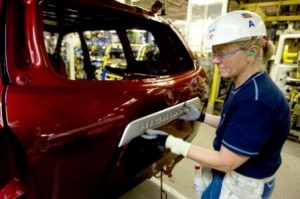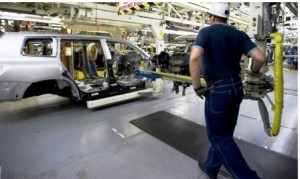Production of the Toyota Highlander compact sport utility vehicle began this month at the company’s plant in Princeton, Indiana. The $450 million investment is part of the sweeping readjustments loss-making Toyota began last year in order to rationalize its manufacturing capacity in North America.
The abrupt change in direction came after the collapse of the full-size SUV and pickup truck markets left its aggressive business plan in tatters.
Toyota had bet — and ultimately lost — billions of dollars on a gamble that American truck buyers who favor Ford, General Motors and Dodge offerings, would defect to a Japanese product. That bet came just as record fuel prices eliminated trucks as and automotive fashion accessory for casual buyers.
Production of the Tundra pickup, originally in Indiana, was consolidated last fall in the brand new Tundra plant in San Antonio, Texas, which was originally developed with a planned capacity of 500,000 units annually.
The Tundra recorded September sales of only 6,308 units.
Since the Texas consolidation, Toyota Motor Manufacturing, Indiana (TMMI), which also builds the Sienna minivan and Sequoia full-size SUV, has been preparing for the Highlander.
In spite of several months of slow production caused by the ongoing Great Recession, TMMI kept all of its 4,200 team members, who were trained in improved manufacturing processes during the lengthy downtimes.
“The result is long-term sustainability of this factory, which is important to our customers, team members, suppliers and the local community,” according to Wil James (sic), TMMI senior vice president.
TMMI now represents a $3.7 billion investment in Indiana. The addition of Highlander also boosts production at other Toyota plants such as West Virginia, where its six-cylinder engine is made.
Since it was introduced in 2000 as a direct answer to the Ford and GM sport utility vehicles, more than one million Highlanders have been sold in the U.S. The Highlander is available in Base, Sport and Limited models in both two-wheel and full-time four-wheel-drive models.
Toyota Motor Corporation (TMC) is also spending another $147 million to install four-cylinder engine tooling at its under used V8 engine plant in Huntsville, Alabama, which is working at about half of its capacity because of the sales failure of Tundra and Sequoia.
These expenses come at a time when Toyota is considering sweeping production decreases of 10% or more at its global factories and is cutting costs by $10 billion in the current fiscal year, which began on April 1. Even so, it is projecting a $6 billion loss this year.
To accomplish the cost savings Toyota is also doing what was, after decades of sustained growth, unthinkable – closing plants abroad and in its home Japanese market. As part of its retrenchment, it is abandoning its only unionized plant in the U.S., New United Motors Manufacturing Inc. (NUMMI) in California, even though California is its largest market by far in U.S.
The world’s largest carmaker appears to have little choice. Toyota Motor Corporation lost more than $815 million in the first quarter of its fiscal year, as revenues declined 38% when compared with its first quarter of last year.
The swing into negative numbers was breathtaking. Net income decreased from ¥353.6 billion to a loss of ¥77.8 billion or $4.52 billion. Major factors for the decline included ¥650 billion due to the effects of declining sales volume and mix, and ¥140 billion due to the appreciation of the Japanese currency, mainly against the U.S. dollar and the Euro.



The Highlander will NOT survive. The profit margin is not there.